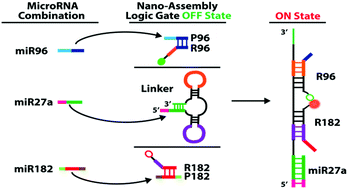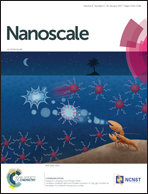Performance of nano-assembly logic gates with a DNA multi-hairpin motif†
Abstract
DNA nano-assemblies have far-reaching implications for molecular computers. Boolean logic gates made from DNA respond to specific combinations of chemical or molecular inputs. In complex samples an assortment of other chemicals and molecules may interfere with the gate's recognition and response mechanisms. For logic gates to accept an increasing number of inputs, while maintaining selectivity, their design must only respond when specific input combinations are available simultaneously. Here we present proof-of-principle for a fluorescent-based nano-assembly logic gate for three inputs. Central to the gate's design is a multi-hairpin motif that distinguishes it from other works in this area. The multi-hairpin motif facilitates a larger and increasing number of inputs and a place to generate FRET-based signal enhancement. We will show the nano-assembly logic gate worked in aqueous buffer and in crude MCF-7 cell lysate. We will demonstrate the gate's selectivity against off-analyte cocktails. Finally, multi-hairpin motifs with different chemical and physical properties were evaluated to test their logic capabilities. Future work will demonstrate the gate's ability to visually identify specific combinations of oligonucleotides called small non-coding RNAs (ncRNAs) in cells. This nano-assembly logic gate for small ncRNA has far reaching cellular computation and single-cell analysis applicability. The gate can be used for basic cellular analysis, computing and observing the unique molecular expression patterns in tumor microenvironments, and advancing the field of therapeutics.



 Please wait while we load your content...
Please wait while we load your content...